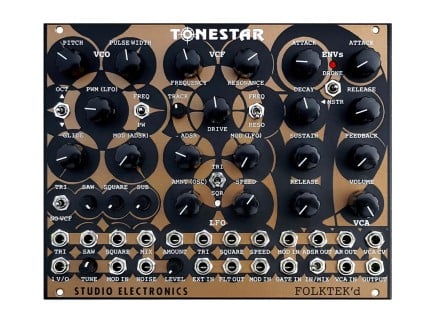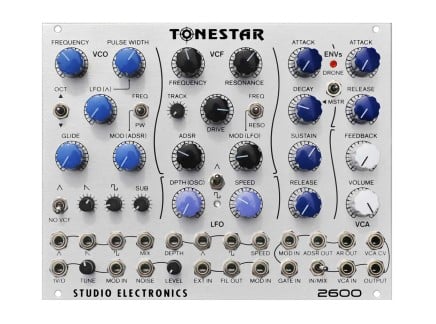In circles of synthesists, the ARP 2600's reputation precedes it: since its 1971 release, it has maintained a respected status and has joined the ranks with the Moog Modular, Minimoog, and others as one of the most important electronic instruments of all time. Despite ARP's original humble intentions, the 2600 quickly found its way into professional studios and the hands of musicians of all styles—and it is still revered as a sort of holy grail of analog synthesis.
If you're not already familiar with the 2600, you've probably heard it. It has been used in all sorts of music, from Stevie Wonder to Weather Report, from Edgar Winter to Jean Michel Jarre. And if you haven't heard it in their music, you probably know it as the voice of R2-D2 in Star Wars, under the control of sound designer Ben Burtt. But in a world where Moog instruments were already the de facto name in high-quality performance and studio synthesizers, where did ARP come from? And in a time where the Minimoog was the go-to stage instrument of many, what did the 2600 itself distinctly offer? What gave it its staying power?
Let's take a look at the history of ARP, and then dive into the details about what makes the 2600 itself such a truly special design.
The Landscape of 1960s Synthesis
Many modern synthesists are familiar with a semi-fictional story about the early years of analog synthesis—a divide between the West Coast and East Coast approaches to analog synthesizer design, each exemplified by two of the earliest makers of modular electronic instruments. Based in California, Don Buchla created instruments intentionally aimed toward the avant garde...and Robert Moog, based in New York, eventually settled on an approach that was more welcoming to commercial and popular musicians.
 Wendy Carlos's Switched-On Bach
Wendy Carlos's Switched-On Bach
Buchla and Moog's design philosophies in some ways can be succinctly epitomized by two famous records released in 1968: Morton Subotnick's Silver Apples of the Moon, which exclusively used a Buchla 100 Series instrument, and Wendy Carlos's Switched-On Bach, which used a Moog modular system to recreate works by 18th century composer J.S. Bach. These records both achieved relative success and renown...but Switched-On Bach reached a wider audience by far, and is often cited as being a touchstone which convinced many that the synthesizer was a viable instrument with eyes toward the future. By presenting familiar music with highly-controlled futuristic sounds, Wendy Carlos in many ways secured Moog synthesizers a respected place in the world of musical instruments. This along with the instrument's increasing presence in emerging popular records (from the Monkees to the Who) made the name "Moog" virtually synonymous with "synthesizer."
As more records began to feature these instruments and progressive musicians such as Keith Emerson (of Emerson, Lake, and Palmer) began to bring them on stage, other designers began to daydream about their own designs and to form their own companies, often using the then-solidifying Moog workflow as a conceptual blueprint for what a synthesizer should be. It is through this form of imitation that the "East Coast" approach took off so rapidly, while the West Coast approach mostly remained in obscurity for decades. Dividing things so evenly into two camps or schools is a bit reductive, though, and perhaps doesn't place proper significance on the approaches of other contemporary designers. One such approach worth knowing is that of Tonus / ARP founder Alan R. Pearlman.
Early History of ARP & the 2500
General electronic music history has favored highlighting the accomplishments of Moog and Buchla, and Alan R. Pearlman as of the moment has not earned quite the level of meticulous documentation and cult following as these other designers. Efforts are now being made to carve more space for Pearlman in the discussion of early synthesizer design—for more information about efforts in that direction, we strongly recommend checking out the Alan R. Pearlman Foundation, a non-profit geared toward re-contextualizing his legacy and providing opportunities to current artists.
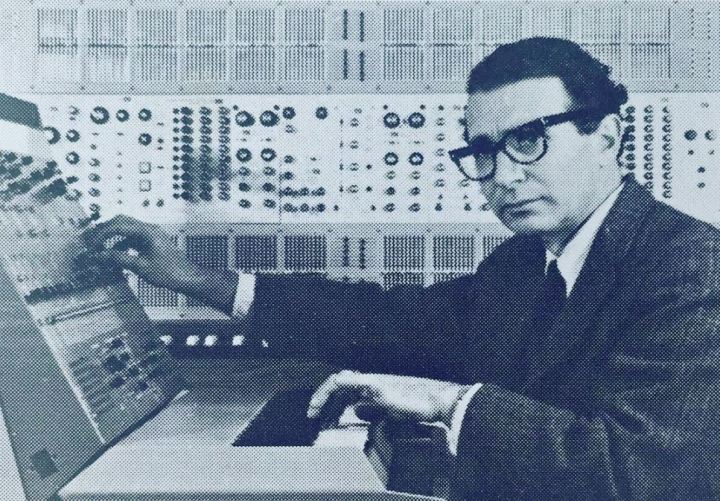 Alan R. Pearlman, via Alan R. Pearlman Foundation
Alan R. Pearlman, via Alan R. Pearlman Foundation
Pearlman was an engineer born into a line of engineers—his father and grandfather designed theater projectors and phonograph parts, respectively. As a student in the late 1940s, Pearlman was already thinking about the potential of electronic music, waiting for the day when engineers would meet the demands of musicians and create an expressive, powerful musical instrument...perhaps not realizing at the time that he himself would be one of them. Years later, upon hearing "Switched-On Bach," Pearlman realized that the time had come. He founded Tonus (eventually re-named ARP), a company aimed toward creating such instruments.
The first Tonus instrument was the gargantuan 2500 system. Like the Buchla and Moog systems that preceded it, the 2500 was a configurable system of modules placed into a single cabinet (or multiple cabinets): bespoke systems whose exact contents were specified by the purchaser. As such, there is no truly "standard" 2500 system—each instrument was unique to the customer's own applications. Systems could come in large full cabinets or smaller "wing" cabinets, intended to be placed to the side of a larger cabinet (though of course, depending on the selected modules, a wing cabinet alone could constitute a full system). There were fewer than twenty distinct modules to choose from, as well as several models of keyboard controllers, many of which featured a combination of "normal" and "inverted"-color stretches of keys which could be assigned to different voices in the synthesizer.
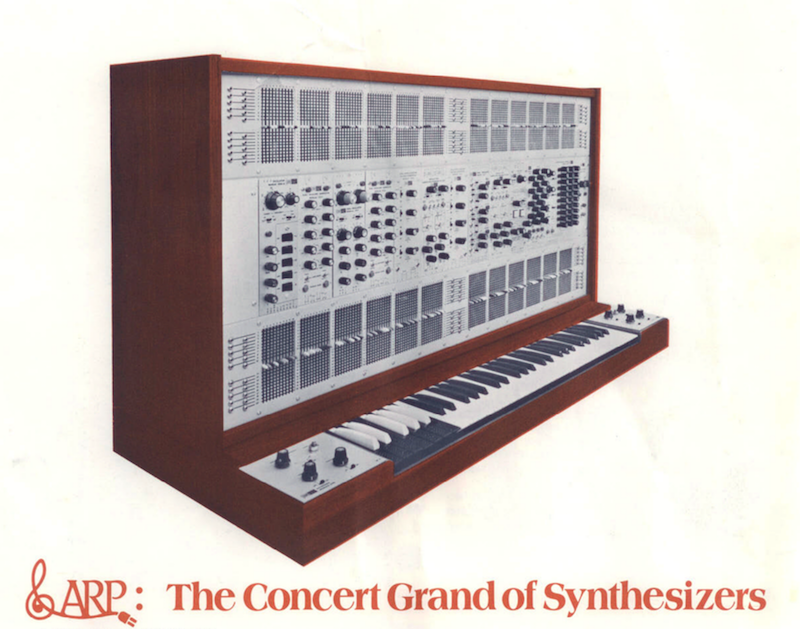
And while it contained several unique and powerful modules, the most significant innovation in the 2500 was its method of patching. Like the modular systems that preceded it, the 2500 required that a user define all of the connections between modules, enabling a high degree of customization of the instrument's overall signal path. However, the 2500 dispensed of the patch cable-based connection approach of the Moog and instead used a series of matrix-based switches built into the cabinet. By standardizing the placement of panel graphics on the module so that labels at the top and bottom of the modules would line up with the position of switches above and below, the 2500 used multiple internal signal busses as a clever form of patching matrix. By connecting an oscillator's output routing switch to the same position as a filter's input routing switch, for instance, a connection could be made without the need for patch cables.
There were multiple advantages to this approach. Perhaps the most practical advantage is that the typical 2500 patch is far less physically cluttered than the typical Moog or Buchla patch. By leaving the panel unobstructed by dangling cables, all panel controls were still easily reachable during performance...so no matter how complex your patch, you could always physically reach the knobs you needed to adjust. Along similar lines, the 2500 was considerably less visually cluttered than other modular systems. Suddenly, visualizing the audio and control paths was no longer a matter of tracing cables between inputs and outputs, but was instead a matter of observing patterns in the switch positions. And because the system used vertical sliding switches rather than rotary switches, the patch routing was something akin to a bar graph—easy to see and understand at a moment's notice once you had spent some time getting to know the system. Of course, there were dedicated I/O jacks connected to each of the internal bus lines—so getting audio or control voltages into or out of the system was possible on any bus line.
 ARP 2500 switch matrix patching example
ARP 2500 switch matrix patching example
The switch matrix approach was a significant step between fully modular systems (like the Moog, which required patch cable connections for the vast majority of signal paths) and semi-modular instruments: devices which feature "default" hardwired signal connections behind the panel. In practice, it wasn't altogether uncommon for ARP 2500 operators to treat specific bus lines as access points for specific signals. For instance, they might leave a sequencer output connected to the top bus line, an LFO output connected to the next line down, a sample & hold output connected to the next line down, and so on, such that they gradually learned to simply switch their input selector switches to the appropriate position for any given patch or effect they might desire. For instance, if they wanted to sequence any given oscillator, they need only switch that oscillator's input to the topmost position. If they wanted instead to use random voltages to control that same oscillator, they need only switch the same input selector switch onto the S&H bus, and so forth. And while the system was fully modular in strict terms, musicians tended to develop their own patching habits and style. This led the 2500 to in many instances act like an arguably more fixed-architecture synth than the average patch-cable based system. More thoughts on this to follow...
There were roughly 100 of these systems built before ARP ceased production in the mid 1970s. Bulky and expensive, much like the Moog systems of the time, the 2500 was never likely to become a hit among performing musicians or musicians operating on a tighter budget. It did find its way into the hands of pioneering electronic composer Eliane Radigue and even eventually onto the records of musicians like Elton John and the Who—but ARP were planning an instrument which could appeal to an even wider customer base.
Birth of the 2600
Thus was born the 2600, designed by Dennis Collin for ARP. Originally conceptualized as a scaled-down, more novice-friendly instrument than the 2500, it features a panel covered in informative graphics, lots of open panel space, and comfortably-spaced controls. It is much smaller than its predecessors, contains built-in speakers, and doesn't even require any patching to get a sound...making it a perfect choice for the classroom. In fact, ARP's initial intention was to market the 2600 primarily to small and mid-size universities who wanted an affordable yet flexible instrument for their electronic music programs. Happily, several popular musicians caught on and made it part of their personal arsenal, valuing it for both its remarkable sonic breadth and its relative ease of use. Like the 2500 before it, the 2600 had its own unique patching paradigm which in many cases could dispense of the logistical headaches associated with patch cables in a modular system. The 2600 made this simpler yet in a few notable ways.
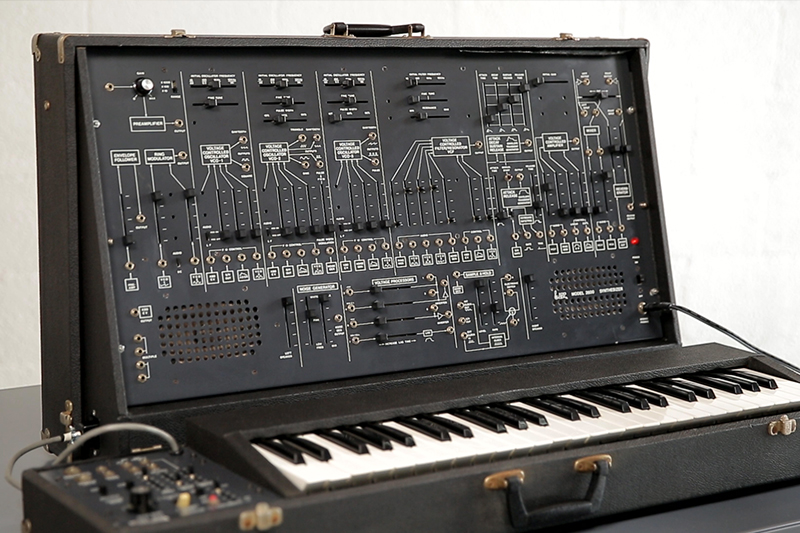
The most obvious and powerful trick in the 2600's design is that it is semi-modular. This implies a couple of things—first of all, the 2600 features a fixed selection of modules behind a single front panel. Unlike earlier modular synths, every 2600 (with some caveats) has the same selection of submodules as every other 2600. While this might initially seem like a disadvantage, it allows something very important: behind-the-panel normalled signal connections between modules. By creating several default signal paths, it became possible to get to the most common desired patches without needing to use cables at all.
Think of the Minimoog: it is comprised of submodules similar to those found in Moog's modular systems, pared down a bit and set to a default signal path. The envelopes are routed to fixed destinations, the oscillators are routed to fixed destinations, etc.—changing the timbre is just a matter of adjusting the balance of sound sources, the intensity of modulation signals, the basic characteristics of the filter, etc. In the end, there are only so many signal routings possible on a Minimoog, meaning that its sound palette, while brilliantly colorful, is relatively limited in favor of ease of use and rapid access to certain types of timbral transformations.
The 2600 is different from this. It has the same sorts of behind-the-panel connections between its modules, but there are a number of key differences. First of all, there are way more internal normalizations and generally more modules behind the panel. Most modulation destinations have several inputs with dedicated mixers, whose signal levels are controlled with attenuation sliders for each input. This means that even without the use of patch cables, for instance, several useful VCO pitch modulation sources are connected to each oscillator all of the time, with their relative impact on the oscillators defined by several large, easily visible sliders. This means that changing your "patch" entirely can be as simple as a matter of adjusting the position of a few sliders rather than repatching entirely...and moreover, the use of long-throw sliders arranged in a row makes it easy over time to relate the instrument's sound to the way that it looks and feels (much like in the 2500).
The other stroke of brilliance implied by its semi-modular nature is that, of course, all of these default signal paths can be completely overridden, unlike in the Minimoog. By using switching Switchcraft Tinijax as signal connectors at each modulation input, the default input signal (as indicated by the panel graphics) can be overridden in favor of any other signal. Of course, part of the 2600's brilliance is that, given the selection of modules available and the extensive use of modulation mixers, most "typical" patches don't necessarily require patching at all—but when they do, there is often a way to do what you need with a relatively low number of cables. Of course, this approach continued to be refined in ARP's later instruments, such as the Odyssey—a non-modular synthesizer which dispensed of patchability in favor of signal selector switches at each of its slider-based signal mixers—but more on that at a later date.
So What's in the ARP 2600?
By the time the 2600 came along, synthesists and synthesizer designers had more or less settled on what the "typical" monosynth patch was like: two or three oscillators mixed together, passed through a filter and then into a VCA, each with their own envelopes, possibly with some end-of-chain panning or reverb. This is exactly the default signal path of the 2600, though as we'll quickly see with a close examination of the panel, things aren't quite that simple. So that in mind, what is actually in a 2600, and what makes its architecture so clever?
External Signal Processing
The top left of the 2600's panel contains several useful modules for external signal processing: a preamplifier, an envelope follower, and a ring modulator. The preamp is great for bringing external sound sources of any sort into the synth: it provides an enormous amount of gain, so that even microphones and lower-level passive electronics can be boosted up to suitable signal levels for processing within the synthesizer. The envelope follower generates a continuously varying voltage based on the loudness of the signal passed into it...allowing dynamic control of the synthesizer from external audio sources. The preamp is normalled to the envelope follower's input, implying that the most common intended use would be to use external mics or instruments as a modulation source.
 Ring modulation examples from the 2600 user manual
Ring modulation examples from the 2600 user manual
The ring modulator is grouped closely together with the external input section. Its default inputs are the first two oscillators' saw and sine outputs respectively (in order to allow for RM timbres even without external audio), but the proximity to the external input suggests that using a combination of internal and external sounds with the ring modulator could produce interesting results...and indeed it does. Also of note—the ring modulator can act in either AC- or DC-coupled modes, meaning that it can be optimized to work with exclusively audio-rate signals or with any combination of audio-rate and sub-audio signals. This means that the ring modulator can be used as a voltage processor, or, in a pinch, it could be used with one audio signal and a control signal (such as that from an envelope or the envelope follower) to create an extra VCA.
The ring modulator is normalled to one of the filter's inputs, but does have its own dedicated output directly on the panel for routing anywhere else in the instrument.
Voltage Controlled Oscillators
The 2600 has three dedicated audio oscillators, each different from the last. They all share a common internal connection to the keyboard's CV: meaning that typically, all three of these oscillators are meant to track the keyboard directly. A switch on each of the oscillators allows for switching between "KBD ON" and "KBD OFF / LF" modes—meaning that each of the three oscillators can be set to ignore the keyboard signal and operate in LFO frequency ranges. So while there is no dedicated LFO on the 2600, it is important to remember that each of its oscillators can go well into the low frequency range. They each offer coarse and fine tuning controls with horizontal sliders toward the top of the modules, modulation inputs at the bottom of the modules, modulation input attenuator sliders above the inputs, and dedicated audio outputs between the sets of sliders.
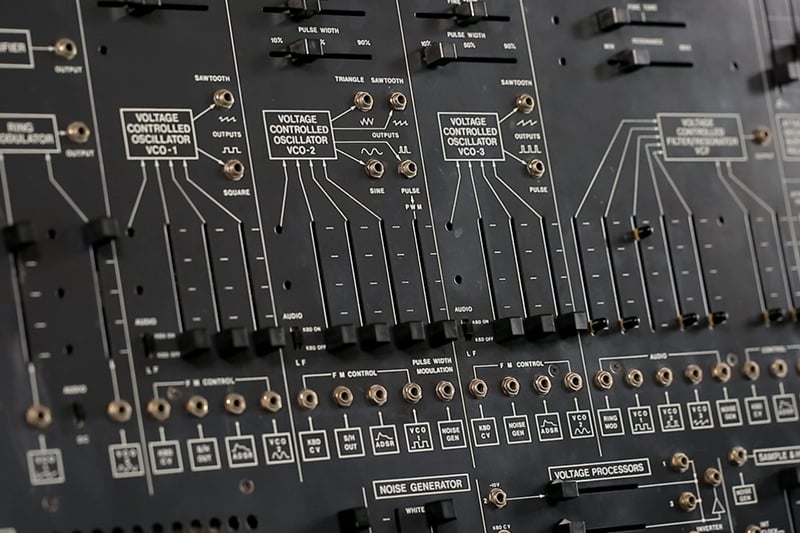
Otherwise, the oscillators are each different from one another. Oscillator 1 provides a saw and square output, a fixed-scaling exponential pitch input normalled to the Keyboard CV, and three variable-amplitude inputs normalled for the Sample & Hold, ADSR envelope, and VCO 2 sine wave, respectively. This enables rapid access to typical keyboard-controlled synth sounds, S&H bleeps and bloops, envelope-controlled VCO lasers, and two-oscillator FM at a moment's notice—and of course, these default signals can be overridden using the CV inputs.
Oscillator 2 is something like an expanded version of the first oscillator. It features four CV inputs normalled to basically the same sources: again, a fixed-scaling exponential input from the keyboard, and scalable connections from the S&H, ADSR, and from VCO 1's square wave output. This enables a different flavor of FM than the sine modulation on oscillator 1—steering clear of a potential point of redundancy. VCO 2 also features four outputs: sine, triangle, saw, and pulse...complete with pulse width modulation.
Oscillator 2 allows both manual and CV-able adjustment of the pulse width. Its PWM can sound staggeringly huge, like a swarm of several slightly detuned oscillators all at the same time. However, one of the more peculiar aspects of the 2600 is that VCO 2 is the only oscillator capable of PWM and the only oscillator with a sine or triangle output...so what you might consider "typical" PWM sounds are not easily possible on the 2600 alone. The 2600 came about at a time before the practice of using a sine or triangle LFO as PWM source was basically standardized, and this direct use seems to have not been part of the instrument's design considerations (though of course, EG-based PWM is easily possible). Moreover, the normalled connection to the PWM CV input comes from quite a peculiar source: the noise generator. In audio range, this produces a strange effect somewhat like mixing noise and a pulse signal—perhaps more interestingly, once in low frequency mode, this allows the creation of random gates which can be used to trigger the envelopes, S&H, and more.
Oscillator 3 is similar to the first, but provides saw and pulse outputs. It does not provide PWM, but does offer manual adjustment of pulse width. And, as with the other oscillators, it seems to intentionally avoid redundancy in the incoming modulation signal path: it features normalled FM connections from the keyboard, noise generator, ADSR, and from VCO 2's sine output. (Note: it's very interesting to monitor only oscillators 1 and 3 while frequency modulating both from VCO 2's sine output. By tuning all oscillators to harmonically-related frequencies, this can yield monstrously huge, complex timbres that shift in shape and form with even slight detuning of the second oscillator).
Different versions of the 2600 use different ICs within the oscillators; as time went on, ARP addressed reliability issues in the oscillators by switching to alternative parts from different semiconductor manufacturers. It is commonly stated that early 2600 oscillators sound better than later ones...but honestly, every 2600 I've ever used has still sounded superb.
Voltage Controlled Filter / Resonator
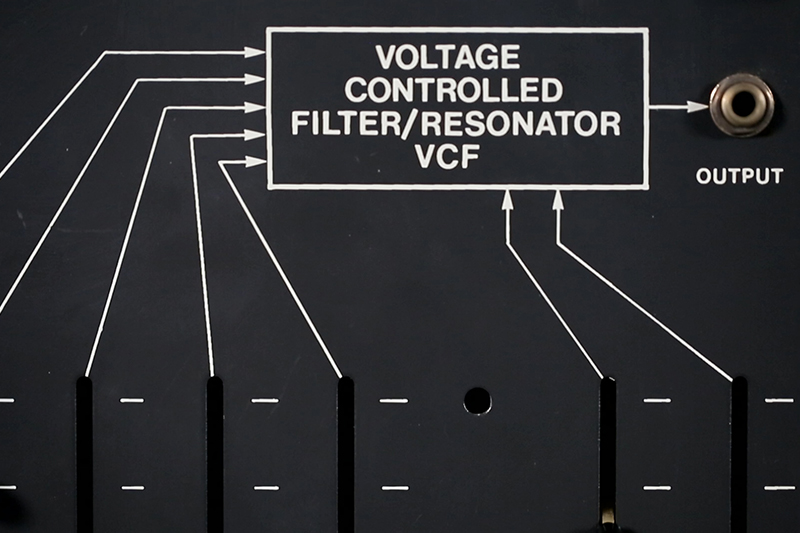 The ARP 2600 Filter / Resonator
The ARP 2600 Filter / Resonator
The 2600 features a single resonant lowpass filter. It can self-oscillate at high resonance settings and tracks 1V/Oct, so it can even act as an additional sine-like oscillator in a pinch. It features normalled CV connections from the ADSR envelope and from the second oscillator's sine wave—which often results in universe-tearing filter FM tones. If you want your 2600 to make intensely aggressive growls and ripping bass and lead tones, keep your hand near the VCO 2 modulation slider on the filter. Of course, with VCO 2 set to low frequency mode, this becomes a more traditional filter "wobble" tone.
Another contributing factor the the 2600's huge sound is its filter's input mixer—which allows a whopping five signals to pass into the filter at any given time. By default, the filter's input mixer is normalled to the ring modulator, VCO 1 square, VCO 2 pulse, VCO 3 saw, and the noise generator. At high level settings, the incoming signals can overload the filter and create a fairly grimy distortion...and as such, the 2600's filter can go from smooth to edgy at a moment's notice.
Of course, not every 2600 features the same filter. Early units featured a design strikingly similar to Moog's patented 24dB/Oct transistor ladder filter...similar enough that threat of lawsuit forced ARP to reconsider their filter design altogether. Later 2600s switched to an original design 24dB/Oct filter, which is commonly considered to feature a design flaw in which the maximum filter frequency is limited to a mere ~12kHz. As such, later 2600s sound much darker than the earlier versions with the Moog filter, but as with the oscillators, even these later "flawed" filters sound spectacular.

Envelopes, VCA, and Output
The 2600 features two functionally distinct envelopes: and ADSR and AR (or ASR). Both envelopes feature a shared Manual Start gate button which can be used in lieu of a keyboard, as well as a normalled connection from a two-to-one switch. One one side of this switch is the keyboard gate signal, which can be used for conventional playing; on the other side is the signal from the S&H's clock generator, which can be used to create recurring articulations which render the envelopes not unlike shape-able LFOs (which can be used to overcome the lack of a sine LFO for PWM, for instance). This section is also the output access point for the keyboard's gate and trigger signals, if one desires to use them as modulation signals or to trigger processes other than the envelopes themselves.
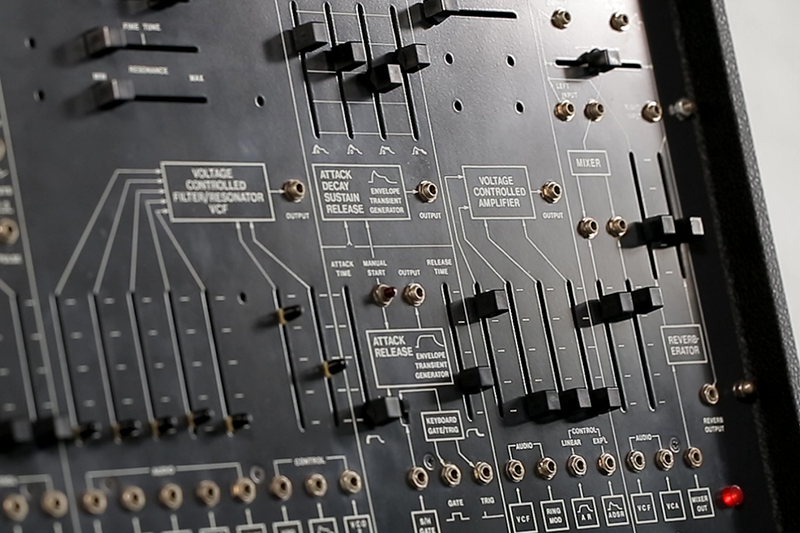
The VCA has a mixer with two audio inputs (normalled from the VCF and the ring mod), and two control inputs. Each of the control inputs is functionally distinct: one has linear input scaling, the other exponential—normalled from the AR and ADSR envelopes, respectively. The modulation sliders can allow for modulation up to relatively high gain values, turning the VCA into a gnarly dynamic distortion. For clean tones, it's advisable to maintain relatively modest CV levels here...it's easy to get this VCA into intense territory. And of course, the VCA also features a default gain offset control, which allows the input signals to pass through even when no modulation is applied.
The right-hand side of the 2600 features several controls related to general output management. At its core is a two-input mixer, a manual panner, and a stereo spring reverb (with independent reverb level for the left and right channels). There are direct inputs and outputs for each of these submodules, so despite their (quite handy) default configuration, they can be used for a broad variety of additional purposes: general purpose signal mixing, continuously variable signal routing, reverberation of external signals, and more.
Of course, one of the quirkiest aspects of the 2600 is the default ending to its signal path: two speakers built into the instrument itself, each with their own level controls. And while these days it seems uncommon for professional instruments to contain, keep in mind the instrument's original intended use in the classroom: in which case, not needing to rely on external amplifiers and speakers for multiple people to hear a sound simultaneously. While these speakers aren't quite powerful enough to play it an ensemble setting, they are a subtle nicety that makes teaching and learning synthesis much simpler in group settings.
Voltage Processors
The bottom section of the ARP 2600's panel is home to several utility modules. These modules are intended for generally simpler functions than the larger voice modules above, but can be employed to produce a vast array of effects to augment the potential of the primary modules.
The simplest of these sections are the Voltage Processors. The voltage processors are general purpose attenuators, inverters, and signal mixers which can be used to scale, offset, and invert audio or CV signals. This section features some interesting normalled connections...including a normalled connection from the keyboard CV through an inverter. This function was famously used by Joe Zawinul on Weather Report's "Black Market," in which the synth parts were played in such a way that the keyboard scaling was "upside down," with higher notes on the bottom end of the keyboard and lower notes on the top.
The Voltage Processors also include a Lag Processor—a "glide" circuit used to add slope to the rising and falling edges of stepped control voltages. This can be used as a very crude/peculiar filter, but is often employed to add smoothing to the signals produced by the next module: the Sample & Hold.
Sample & Hold and Noise
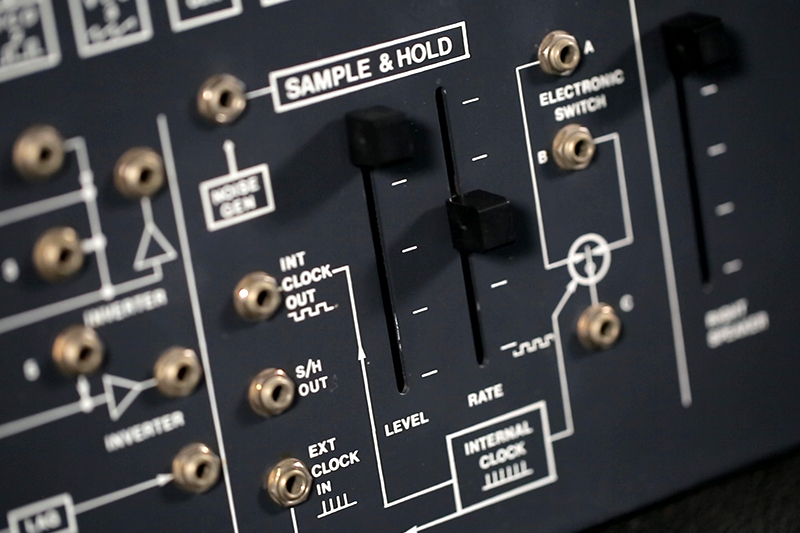 Close-up of the ARP 2600 Sample & Hold section
Close-up of the ARP 2600 Sample & Hold section
The Sample & Hold is a fairly straightforward S&H circuit: it samples incoming voltages at intervals determined by a clock. The 2600's S&H features a dedicated level control and a clock generator with a direct output, great for use as an auxiliary square wave LFO. The clock generator doesn't offer CV control of its rate, but an external clock input can be used to bypass the normalled connection of the S&H clock to the S&H's hold input. The internal clock is also used to operate a bidirectional (2-to-1 or 1-to-2) switch, allowing for intricate signal distribution schemes.
The S&H can, of course, sample any incoming signal to convert into a stepped voltage. Using the 2600's oscillators as the sample source can result in evolving, semi-repetitive patterns, which sound excellent when applied to the filter's cutoff, or even to another oscillator's pitch—producing a sequence-like string of notes. However, by default, the S&H is normalled (as in many synths) to the output of the noise generator.
The Noise source itself is pretty special: rather than offering the typical static noise colors of many synths, it provides continuously variable noise color. It provides everything from white noise to a low-frequency, rumbling random fluctuation, passing through pink and red noise on the way. It also features its own dedicated level control, making it easy to dial in the intensity of several downstream modulation destinations all at once.
The Keyboard

Of course, the other half of the 2600 is perhaps equally important: the keyboard. The 2600 was distinct from several of its portable synthesizer contemporaries in that its keyboard was not directly attached to the synthesizer itself—instead, it was connected via a single multi-conductor cable, which provided pitch, gate, and trigger signals to the main synthesizer. (Note: this design feature was notably exploited by Edgar Winter, who attached straps to his 2600's keyboard to use onstage as a prototypical keytar, as seen on the cover of his album Standing On Rock.)
As with the 2600 itself, ARP produced several different versions of the keyboard itself. The earliest version, the 3601, featured a master tuning control and dedicated portamento circuit. The 3604 added adjustable keyboard scaling (for creating microtonal and other non-12-TET scales), but otherwise was similar in function to the 3601. Perhaps the most interesting historic 2600 keyboard, though, was the 3620. The 3620 added a host of new features: an extended portamento circuit, octave transposition switch, a performance pitch bend knob, and an integrated LFO which performs vibrato and note repeat functions.
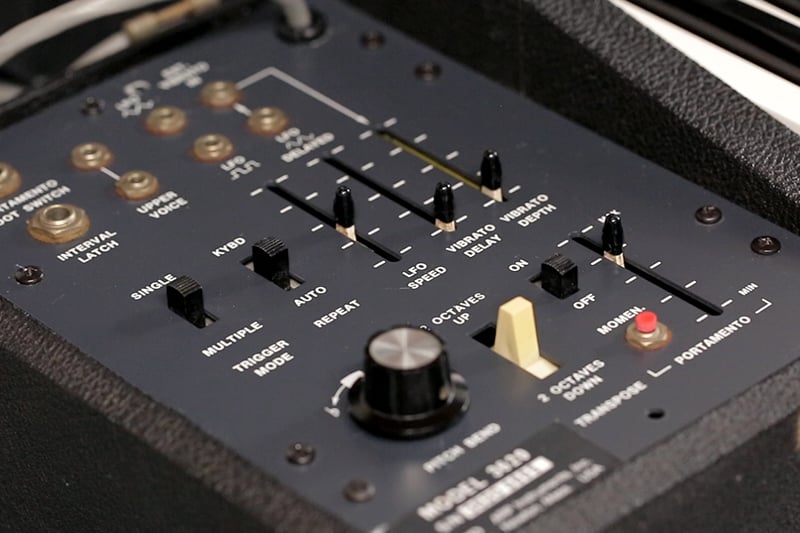 Close-up of the 3620's left-hand controls
Close-up of the 3620's left-hand controls
The pitch bend, portamento, and transposition controls are conveniently located next to one another in such a way that they could all be rapidly accessed (even in combination) from the left hand alone, allowing for extended expressive potential. The bend knob is unsprung, but is scaled in such a way that access to common "bend" ranges is quite easy without having to struggle too much with tuning: there is a very broad dead spot at the center, with the majority of the travel of the knob in either direction producing only up to a whole tone bend. The portamento features a time control and on/off switch—but perhaps more interestingly, it features a momentary "on" pushbutton which could be activated by the thumb, allowing players to quickly switch between portamento and non-portamento note transitions.
The built-in LFO provides both direct sine and square wave outputs (and therefore helps to overcome the aforementioned PWM "problem"). The LFO signal features an intensity control, and is summed with the keyboard CV itself to create vibrato tones. The 3620 also includes a delay control for the vibrato LFO, allowing vibrato to fade in gradually over time. It can also use an external vibrato input, which allows you to mix external signals with the keyboard CV rather than the 3620's built-in LFO. The LFO also enables access to a couple of different note repeat modes, in which the keyboard's gate output is ignored or combined with the internal square LFO in different ways. In "AUTO" mode, the keyboard gate is ignored and the LFO's square wave is instead passed along to the 2600, automatically retriggering the envelopes with each cycle of the LFO. In "KYBD" mode, the LFO's square wave and keyboard gate are combined via a logical AND operation, so that the LFO retrievers the envelopes only when a key is held. This is a great way to trigger flurries of repeated pitches.
The 3620 also includes a latch pedal input and portamento activation foot switch input, as well as a switch that selections between "single" or "multiple" trigger modes (for legato or tenuto articulation styles, respectively). Perhaps most interesting of the 3620's features, though, is that it is duophonic: it features a dedicated "upper voice" CV output which produces a CV that corresponds to the highest currently pressed key. In this way, it is possible to control the pitch of multiple 2600 oscillators independently from one another...using the normalled keyboard connection for one or two oscillators and defeating the normalled connection from the 3620's "upper voice" output for the other(s).
The 3620's particularly special features will likely be familiar to users of the ARP Odyssey, which features the same options for auto-repeat and duophony. In fact, the Odyssey is in many ways a compact, hard-wired 2600...but again, let's revisit that in a future article.

The 2600 is a deep, powerful instrument that, despite humble initial intentions, has become one of the most revered synthesizers of all time. It has inspired countless spin-offs and derivative designs, ranging from the currently available Studio Electronics Tonestar 2600, and even the new Korg ARP 2600 M, a faithful reproduction of the 2600 itself with a reduced overall size. Arturia even offers a software version as part of their V Collection suite: the 2600 V.
The 2600 has inspired countless musicians to date—it provided a unique and uncommonly well-considered approach to analog instrument design, and many of its rules and design considerations are still followed to this day. It provided a perfect mix of open-endedness and ease of use, providing experimental musicians everything they needed to discover new sounds, and providing commercial musicians an interface that allowed them uncommonly immediate and expressive control. And given its enduring presence in schools, studios, and popular culture, it will no doubt continue to teach many about the joys of manipulating sound and creating electronic music.
Consider supporting the Alan R. Pearlman foundation: a non-profit organization dedicated to documenting and preserving the history of Alan R. Pearlman's musical innovations. The foundation is just starting out, but has a broad range of fantastic projects on the horizon, ranging from engineering and music scholarships to artist residencies, public concerts, and more. Find out more about the Alan R. Pearlman foundation here.


